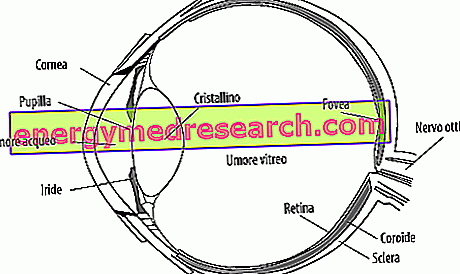Anatomy of the Eye
The eyeball is located in the orbital cavity, which contains it and protects it. It is a pyramid-shaped bone structure, with a posterior apex and anterior base.
The wall of the bulb is formed of three concentric tunics which, from the outside towards the inside, are:
- External frog (fibrous): formed by the sclera and cornea
- Medium (vascular) tunic also called uvea : formed by the choroid, the ciliary body and the crystalline .
- Internal tunic (nervosa): the retina .
The external tunic acts as an attack for the extrinsic muscles of the eyeball, ie those that allow its rotation downwards and upwards, to the right and left and obliquely, inwards and outwards.
In its five posterior sixths it is formed by the sclera, which is a resistant and opaque membrane to luminous rays, and in its sixth anterior by the cornea, which is a transparent structure devoid of blood vessels, and which is therefore nourished by those of the sclera. The cornea is formed by five overlapping layers, of which the outer one is formed by epithelial cells arranged in several overlapping layers (multilayered epithelium); the underlying three layers are formed by connective tissue and the last, the fifth, again by epithelial cells but in a single layer, called endothelium.
The medium or uvea tunic is a membrane of connective tissue (collagen) rich in vessels and pigment and is interposed between sclera and retina. It has the function of support and nutrition for the layers of the retina that are in contact with it. It is divided from front to back, in iris, ciliary body and choroid.

The iris is the structure that typically bears the color of our eyes. It is in direct contact with the crystalline lens and has a central hole, the pupil, through which light rays pass.
The ciliary body is posterior to the iris and is covered inside by a portion of the retina called "blind" because it does not contain any photoreceptor and therefore does not participate in the vision.
The choroid is a support for the retina and is very vascularized, just to nourish the retinal epithelium. It is brown, rust-colored, due to the presence of a pigment that absorbs light rays, preventing them from reflecting on the sclera.
The internal habit is formed by the retina . It extends from the point of emergency of the optic nerve to the pupillary edge of the iris. It is a thin transparent film formed of ten layers of nerve cells (neurons to all effects), including, in its non-blind portion - called optical retina - the cones and rods, which are the photoreceptors appointed to visual function.
The rods are more numerous than the cones (about 75 million) and contain a single type of pigment. For this they are deputies to the twilight vision, that is they see only in white and in black.
The cones are in smaller number (about 3 million) and are used for the distinct vision of colors, containing three different types of pigment. Almost all of them are concentrated in the central fovea, which is an ellipse-shaped area that coincides with the rear end of the optical axis (the line that passes through the center of the eyeball). It represents the site of the distinct vision.
The nerve extensions of the cones and rods are joined together in another very important portion of the retina, which is the optic papilla . It is defined as the point of emergency of the optic nerve (which brings visual information to the cerebral cortex, which in turn re-elaborates it and allows us to see images), but also of the central artery and vein of the retina. The papilla is not covered by retina, it is blind.
Physiology of optics
Light is a form of radiant energy that allows the vision of the objects that surround us.
In a transparent medium the light has a straight path; by convention (for sure) it is said that it travels in the form of rays.
A beam of rays can be formed by converging, divergent or parallel rays. The rays coming from the infinite, which in optics is considered already starting from a distance of 6 meters, are called parallel. The point where converging or divergent rays meet is called fire .
When a beam of light rays meets an object you will have two possibilities:
- It will undergo the phenomenon of refraction, typical of transparent objects. The rays pass through the object undergoing a deviation which will depend on the refractive index of the object in question (which in turn depends on the density of the matter of which the same object is formed) and on the angle of incidence (angle formed by the direction of the light beam with the perpendicular to the surface of the object).
- It will undergo the phenomenon of reflection, typical of opaque bodies: the rays do not cross the object but are reflected.
Spherical lenses are transparent means delimited by spherical surfaces, which can be concave or convex and which represent spherical caps. The ideal center of the sphere of which the surfaces are part is called the center of curvature, the radius of the sphere is called the radius of curvature, the ideal line joining the two centers of curvature of the surfaces of the lens is called the optical axis.
The spherical surfaces of the lens can be convex or concave; they have the ability to measure the direction of light rays ( vergence ) that cross them.
In a convergent system, that is, parallel rays coming from a luminous point placed at infinity, will be refracted posteriorly on the optical axis at a distance from the vertex of the lens correlated to the radius of curvature and to the index of refraction of the same lens. By moving the light from infinity to the lens (distance less than 6 meters), the rays will no longer be parallel but divergent. The back fire tends to move away proportionally to the increasing angle of incidence. As we progress in approaching the luminous point to the lens, we will arrive at a position in which, by increasing the angle of incidence, the rays will emerge parallel. For further approaches of the luminous point, the rays will emerge divergent and their focus will be virtual, being on the extensions of the same rays.
The convex lenses induce a positive virginity, that is they make the light rays that cross them converge towards a point called fire, enlarging the image. This is why they are called positive spherical lenses. The fire of these rays is real.
The concave lenses induce a negative virginity, that is they make diverge the light rays that cross them decreasing the magnitude of the observed image. This is why they are called negative spherical lenses. The fire of these rays is virtual and can be identified by extending backwards the rays emerging from the lens.
The power of the lenses, ie the amount of convergence or divergence induced by a given diopter (the lens), is called dioptric power and its unit of measurement is the diopter . It corresponds to the inverse of the focal distance expressed in meters, according to the law
d = 1 / f
where d is the diopter and f is the focus. Therefore a diopter is one meter.
For example, if the fire is 10 centimeters, the diopter is 10; if the fire is one meter, the diopter will be one. The lower the focus, the greater the dioptric power, ie the smaller the distance the more convergence increases.
The fundamental property of the eye is the ability to modify its characteristics according to the object observed, so that its image always falls on the retina. For this reason the eye is considered as a compound diopter, consisting of several surfaces. The first separation surface is the cornea, the second is the crystalline. They form a converging lens system .
The cornea has a very high dioptric power, equal to about 40 diopters. This value is explained by the fact that the difference between its refractive index and that of air is very high. Under water, on the other hand, we do not see ourselves because the refractive index of cornea and water are very similar, so the fire is not on the retina but far beyond it.
The pupil foramen has a diameter of about 4 millimeters, it widens when the brightness of the environment decreases and shrinks when it increases. The average length of the eyeball is 24 millimeters, and it is the length that allows the parallel rays that pass through the lens to be focused on the retina. From this it can be deduced that a greater or lesser length of the bulb causes visual defects.
Having said this, we can say that in a normal eye ( emmetrope ) the rays coming from the infinite (from 6 meters onwards) fall exactly on the retina. Therefore, to have emmetropia, there must be a right relationship between ocular dioptric power and bulb length. When this does not happen, the eye is called ametrope and we have the refraction vices that cause the most common sight defects.



